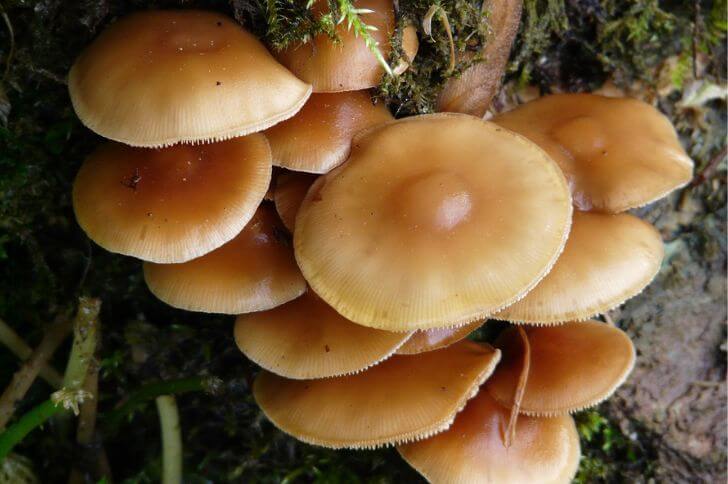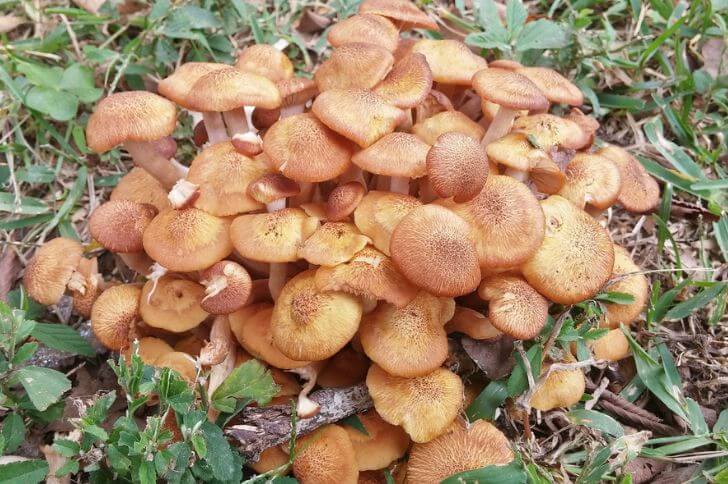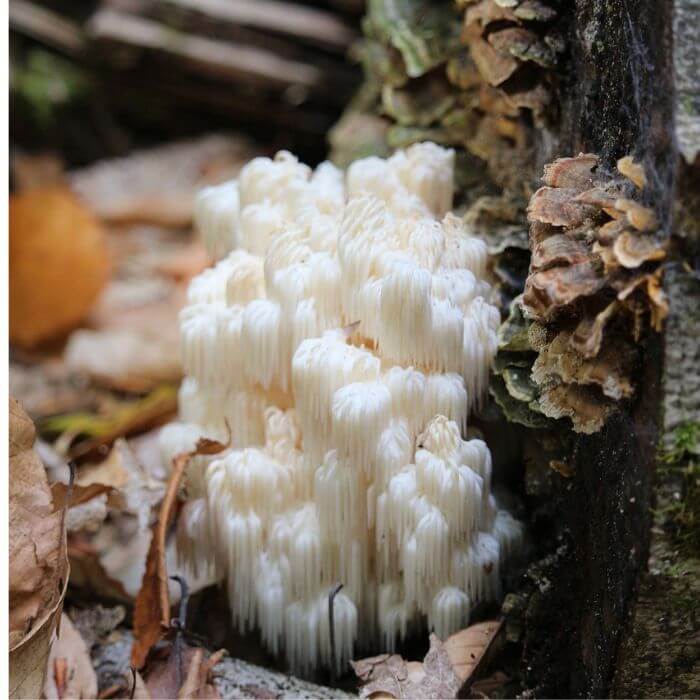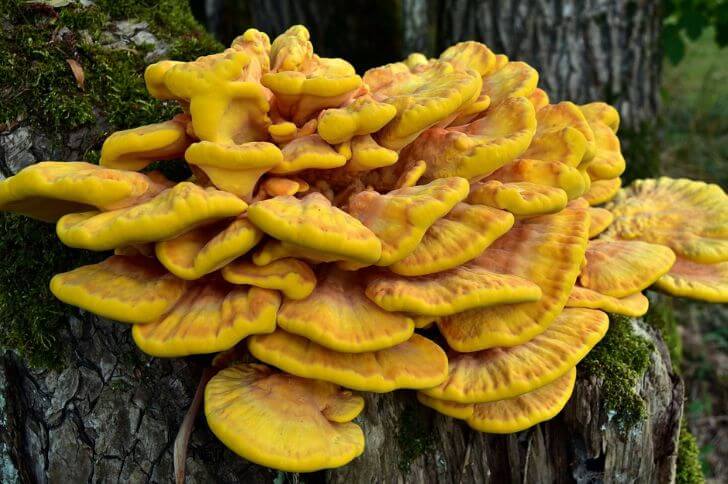Stump mushrooms encompass a wide variety of fungal species that thrive on decaying wood, particularly tree stumps or fallen logs.
Their presence adds an enchanting touch to forest landscapes, hinting at the intricate processes of decomposition and symbiosis occurring within these ecosystems.
But beyond their aesthetic appeal, stump mushrooms play crucial roles in nutrient recycling and ecosystem function, making them an integral part of nature’s intricate web.
List of Stump Mushrooms
1. Velvet shanks

Velvet shanks are a fascinating species of stump mushrooms that thrive in the dark and damp environments of decaying wood.
Their unique and velvety cap texture sets them apart from other stump mushrooms, making them a visually striking addition to any woodland setting.
What’s particularly interesting about velvet shanks is their ability to survive harsh winters, continuing to grow and fruit during colder months when other mushrooms may lay dormant. This resilience makes them a symbol of strength and determination in the world of mycology.
But it’s not just their appearance and resilience that make velvet shanks intriguing; they also offer an excellent source of nutrition. These mushrooms are rich in essential vitamins, minerals, and antioxidants, making them a valuable addition to any diet.
2. Honey mushrooms

Honey mushrooms are a fascinating and often underappreciated type of stump mushroom. These resilient fungi have a unique ability to colonize and decompose wood, making them a common sight on decaying stumps and logs.
What sets honey mushrooms apart is their distinct honey-colored caps and the interconnected network of fine white strands known as mycelium that they form beneath the surface.
One of the most intriguing aspects of honey mushrooms is their culinary potential. Despite being generally considered edible, there’s a crucial distinction to be made between different species within the honey mushroom genus, some of which can cause gastrointestinal upset in certain individuals.
However, foraging for these wild mushrooms can be a rewarding experience for adventurous food enthusiasts who seek out their rich, earthy flavor.
With proper knowledge and caution, incorporating honey mushrooms into your cooking repertoire can add an unexpected depth of flavor to soups, risottos, and other dishes.
3. Hericium Erinaceus

Known for its unique appearance and impressive health benefits, the lion’s mane mushroom is a fascinating addition to the world of stump mushrooms.
This distinctive fungus features cascading white strands that resemble a lion’s mane, making it an eye-catching sight in forested areas.
Another intriguing fact about Hericium erinaceus is its culinary versatility. With a texture similar to seafood and a mild nutty flavor, this mushroom has gained popularity as a meat substitute in vegetarian and vegan dishes.
Its ability to absorb flavors makes it an ideal ingredient for stir-fries, soups, and pasta dishes. As consumers continue to seek alternative sources of protein and unique culinary experiences, Hericium erinaceus offers an exciting opportunity for experimentation in the kitchen.
4. Sulphur shelf mushrooms

Sulphur shelf mushrooms, also known as chicken of the woods, are a vibrant and captivating addition to the world of stump mushrooms.
These striking fungi boast a bold orange or yellow hue that stands out amidst the monotony of tree stumps and decaying logs.
What makes sulphur shelf mushrooms particularly intriguing is their unique taste, often described as reminiscent of chicken or lobster. This culinary versatility adds an exciting dimension to foraging and cooking with wild mushrooms.
One fascinating aspect of sulphur shelf mushrooms is their ability to thrive on living trees as well as decaying wood, making them a formidable force in the natural ecosystem.
Their adaptability showcases nature’s tenacity and resilience in utilizing available resources for growth. Beyond their visual appeal and culinary potential, these remarkable fungi serve as a reminder of nature’s innovative strategies for survival and proliferation.
5. Trametes Versicolor (Turkey Tail mushrooms)
Trametes versicolor, also known as turkey tail mushroom, is a fascinating and beautiful fungus that can often be found growing on tree stumps.
Its vibrant concentric rings of brown, orange, and white give it the appearance of an artist’s palette or the plumage of a wild turkey, hence its name.
Are these mushrooms edible? Yes, turkey tail mushrooms are ground and used in shakes, teas and more.
As we continue to explore the natural world around us, it’s clear that even the most unassuming organisms like Trametes versicolor can hold remarkable secrets waiting to be unveiled. Whether you’re drawn to their stunning appearance or intrigued by their medicinal potential, these stump mushrooms remind us of the wondrous diversity and untapped knowledge still present within nature’s creations.
6. Armillaria Ostoyae
Armillaria ostoyae, another type of honey fungus, is a fascinating species of mushroom that presents both opportunities and challenges for foragers.
Its identification can be tricky due to its resemblance to the ‘true’ honey mushroom (Armillaria mellea), but there are key distinguishing features such as the darker spore print and slender ring on the stem.
Are armillaria ostoyaes edible? Yes. When identified correctly and cooked thoroughly, Armillaria ostoya can add a delightful earthy flavor to dishes. One popular method of preparation involves sautéing the sliced mushrooms with garlic and butter until golden brown.
The caramelized flavors complement a variety of culinary creations, from creamy risottos to hearty stews. With careful identification and thorough cooking techniques, this mushroom has the potential to surprise even the most discerning palates.
For those eager to explore new flavors in their cooking repertoire, Armillaria ostoyae presents an intriguing opportunity. Its unique characteristics challenge us to harness its potential while respecting its potential risks – creating a delicate balance between culinary adventure and mindful caution.
7. Gymnopilus Junonius (Spectacular Rustgill)
The Gymnopilus junonius, common name Spectacular Rustgill, is a dull-looking stump mushroom that can be found in various parts of the world. Its brown cap grows up to 12 inches wide and its stem about 10 inches long.
What sets this brown fungus species apart is its ability to thrive on decaying wood, often spotted growing in clusters on tree stumps or logs.
Where can you find the spectacular rustgill? They are common in Australasia. Spectacular rustgills are inedible.
8. Hypholoma Capnoides (Conifer Tuft)
Common in North America and Asia, the hypholoma capnoides, commonly known as the Conifer Tuft, is a strikingly beautiful species of stump mushroom often found on decaying conifer stumps and logs.
How can you identify these mushrooms that grow on logs? This mushroom is often confused for the sheathed woodtuft or the funeral bell mushrooms.
Conifer tufts fruiting bodies grow in clusters. Each mushroom has a small cap, around 2.5 inches wide and may have veil remnants around its edges.
Underneath the gills are gray and the stipe is yellowish. Are conifer tufts edible? Though some mushroom enthusiasts consider them edible, unless you can identify them correctly we recommend you avoid them due to their close resemblance to funeral bells.
9. Meripilus Sumstinei (Black-staining Polypore)
Meripilus sumstinei, common name Black-Staining Polypore, is another type of stump mushroom that can be found in various forested regions across North America.
Its unique characteristics make identifying it a rewarding challenge for both amateur and professional mycologists alike. One key feature of Meripilus sumstinei is its dark, bruise-like staining when handled or damaged, setting it apart from similar species.
Additionally, its large size and tendency to grow on hardwoods like oak and hickory provide further clues for accurate identification.
Also, this particular species often forms large overlapping clusters on the lower trunk or roots of trees, creating an impressive display that catches the eye of observant nature enthusiasts. Another distinguishing trait is its white pore surface that turns brown with age, adding to the allure of discovering this intriguing fungus in the wild.
Despite its captivating appearance and intriguing behavior, Meripilus sumstinei remains relatively understudied in comparison to other fungal species. This lack of attention highlights the need for further research into the ecological role and potential benefits of this remarkable stump mushroom.
10. Kuehneromyces Mutabilis (Sheathed Woodtuft)
Kuehneromyces mutabilis (sheathed woodtuft) is a fascinating species of stump mushroom that can be found growing on decaying tree stumps and logs.
What sets this mushroom apart from others is its unique ability to change color as it matures, starting off as a pale yellowish-white before gradually turning into a deep brown or chestnut color.
This transformation not only makes Kuehneromyces mutabilis visually striking but also adds an element of mystery to its presence in the forest.
One of the most intriguing aspects of the sheathed woodtuft is its culinary potential. Despite being lesser-known compared to other edible mushrooms, this species has a delicate flavor and firm texture that make it an excellent addition to various dishes.
With proper identification and preparation, foraging enthusiasts can enjoy the earthy taste and nutritional benefits of this mushroom while also appreciating the natural beauty it brings to woodland environments.
11. Psathyrella Piluliformis (Common Stump Brittlestem)
Psathyrella piluliformis, also called common stump brittlestem mushroom, is a fascinating and often overlooked species found in wooded areas around the world.
This unassuming mushroom grows in clusters on decaying wood, particularly stumps and fallen logs, and is easily identifiable by its small size and distinct slimy texture.
What makes common stump brittlestem unique is its ability to thrive in cooler temperatures, making it a common sight in temperate forests during the fall and early winter months.
12. Dryad’s Saddle
One of the most common bracket fungus that grows on logs is the dryad’s saddle. Also called pheasant’s back mushroom, it is a magnificent sight to behold.
With its unique fan-shaped fruiting body and striking brown and white scales, this species stands out among stump mushrooms. Found predominantly on tree stumps and logs, Cerioporus squamosus is a resilient fungus that thrives in wooded areas and brings a unique look to its surroundings.
Are dryad’s saddles edible? Yes, when young these mushrooms that grow on stumps are edible.
Final thoughts:
Exploring the different types of mushrooms that grow on stumps can provide a fascinating insight into the diversity of fungal life.
From the delicate lion mane mushroom to the iconic chicken-of-the-woods, these species play a crucial role in forest ecosystems and offer unique culinary benefits. As we continue to study and appreciate these remarkable organisms, it becomes clear that they hold untold secrets waiting to be unlocked.
By learning more about their growth habits and ecological significance, we can better understand how to conserve and utilize them sustainably. So, next time you encounter a stump in the woods, take a closer look – you might just discover a world of captivating fungi waiting to be explored.
source:
Hi There,
My name is Jenny. I’m the Chief Editor at Try Green Recipes and besides making yummy and healthy foods for my kids, grandkids, and friends. I’m new to the blogging world but I believe what I have to share is unique and will bring joy to your home. If you are adventurous and want try something tasty, let’s get started.

